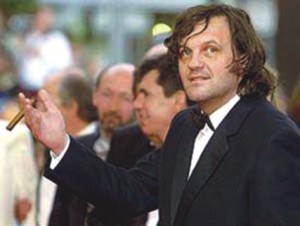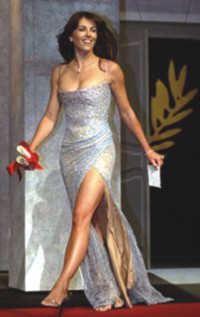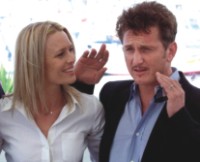|
Cinema
The
Sand The Sea and The Stars
Belgian
brothers Jean-Pierre and Luc Dardenne took their second Palme
d'Or at the closing ceremony of the 58th Cannes Film Festival
last week.
Their
film, L'Enfant, a story of two young street urchins living
off crime to buy food for their new baby, was a critics' favourite
to win the most prestigious prize in world film-making, beating
off strong competition from 21 films by directors including
Jim Jarmusch, Atom Egoyan, David Cronenberg, Wim Wenders and
Lars von Trier.

Director Lars Von Trier. |
This
latest triumph follows the Dardennes' victory in 1999 for
Rosetta. The pair, both in their fifties, have become European
art-house darlings for their distinctive hand-held style and
tough, socially-conscious subject matters.
A fairly
safe set of awards marked a return to Cannes tradition of
rewarding true auteurs after the controversy of American documentary
maker Michael Moore winning last year with Fahrenheit 9/11.
The Grand
Prix runner up for best film went to Jim Jarmusch for his
wry film Broken Flowers, starring Bill Murray as an ageing
Don Juan on an odyssey to find the son he never knew he had.
Hollywood
star Tommy Lee Jones won the best actor prize for his performance
in The Three Burials of Melquiades Estrada, a Western he directed.
It was the second Palme d'Or for the Dardenne brothers, having
previously been awarded the prize in 1999 for controversial
drama Rosetta.
Israel's
Hanna Laslo won the best actress prize for her performance
in Free Zone, a drama envisioning a Middle East freed of its
borders.
Laslo,
who accepted the prize from actor Ralph Fiennes at a gala
ceremony, dedicated the prize to her mother, a Holocaust survivor.
The special jury prize went to Chinese director Wang Xiaoshuai's
Shanghai Dreams, which tells of a family's turmoil as it tries
to leave the backwater town it was sent to in a state programme
to develop rural areas.
The Three
Burials of Melquiades Estrada was also named best screenplay,
Michael Haneke was best director for Hidden and Wayfarers
by Ukraine's Igor Strembitskyy was named best short film.
US director Miranda July and Sri Lanka's Vimukthi Jayasundara
shared the Golden Camera award for first-time directors. This
year's Palme d'Or competition was dominated by arthouse veterans
-- in contrast to last year, when Michael Moore's Fahrenheit
9/11 won.

Bosnian director Kusturica, one of the judges. |
The
21 movies in competition included works by Gus Van Sant, Lars
von Trier and Wim Wenders. The Palme d'Or was presented by
Oscar winners Morgan Freeman and Hilary Swank on Saturday,
the final day of the festival.
Before
the announcement, Cannes jury head Emir Kusturica said the
contenders would be judged on "aesthetics". Mexican
actress Salma Hayek and Spanish actor Javier Bardem were on
the nine-person panel alongside Bosnian director Kusturica.
The Cannes film festival is the world's most prestigious film
industry gathering, attracting more than 40,000 movie industry
workers every year.
It opened
on 11 May with a gala showing of movie Lemming starring Charlotte
Gainsbourg and British actress Charlotte Rampling. Out of
competition, Revenge of the Sith - the final installment of
George Lucas' Star Wars series - was given its world premiere
during the festival.
This year's
word-of-mouth hit features a risky mix of sex, children and
the internet. There are a lot of conversations among Cannes
festival-goers that start: "Seen anything good?"
Discussions tend to ensue about the big-hitters from the main
Palme d'Or competition: Gus Van Sant, Carlos Reygadas, David
Cronenberg and the like. But then, chances are someone will
pipe up: "And I've seen this really nice film called
Me and You and Everyone We Know."

Elizabeth
Hurley |
Written,
directed by and starring a 32-year-old American performance
artist called Miranda July, the film, her debut feature, is
showing in the Critics' Week section of the festival. And,
without a doubt, it is this year's Cannes word-of-mouth hit.
Filmed in the suburbs of Los Angeles, Me and You and Everyone
We Know interweaves the story of Christine, an artist (played
just this side of whimsical by July herself), with that of
shoe salesman Richard, who, at the moment of splitting up
with his wife, douses his hand with lighter fluid and sets
it aflame. He is a man burned, literally and metaphorically.
Along
the way we encounter the curious, funny lives of Richard's
children - the younger of whom, the six-year-old Robby enters
into an online dialogue with a mysterious woman with certain
sexual predilections.
Already
feted at Sundance, Me and You and Everyone We Know is charming
Cannes audiences with its quirky vision, as it interrogates
with witty lightness of touch those age-old preoccupations
of the struggle to connect with other people, the alchemy
of love, and the hunger of loneliness. The interstices between
childhood and adulthood are deftly investigated: the children
in the film seem at times knowing in their grasp of the world,
better able in their naivety to connect with others than the
blundering adults - and at others deeply vulnerable.
Perhaps
one of the reasons the film seems so fresh is that July -
a slight and rather wide-eyed figure, with a mop of curly
brown hair - is entirely self-taught, and simply found herself
writing her first film one day as she took a train ride through
Chicago. Raised in Berkeley, California, she dropped out of
university, but "I started writing plays at 16 and putting
them on, then making little movies, doing everything my own
way, teaching myself in my own room, kind of like Christine."
 If
that makes her sound like a jack of all trades (and not all
her work has been brilliantly received on this side of the
Atlantic), she says the disparate strands come from the same
place, are part of the same project. "It's all one thing.
The differences have more to do with venues and audiences
and, yes, craft. Some media are better for bringing out different
feelings," she says. "On a particular day, I may
not feel like someone who could perform, but someone who could
write a short story. I will always do all of these things
because that's what makes me happy." If
that makes her sound like a jack of all trades (and not all
her work has been brilliantly received on this side of the
Atlantic), she says the disparate strands come from the same
place, are part of the same project. "It's all one thing.
The differences have more to do with venues and audiences
and, yes, craft. Some media are better for bringing out different
feelings," she says. "On a particular day, I may
not feel like someone who could perform, but someone who could
write a short story. I will always do all of these things
because that's what makes me happy."
The nature
of childhood and childhood sexuality are themes she has explored
in previous works. Of the kids in the film, she says: "I
am attracted to children like that. When I was growing up,
I was in an adult world. My parents didn't really create a
children's world for me and my brother. I was childlike and
spaced out but I also had an ability to connect in an adult
world. It's not that surprising. Children often have a certain
maturity."
Despite
the fact that the film seems to exemplify the best of American
independent film-making, ironically it would never have been
made if Britain's FilmFour had not taken the plunge and part-funded
it, persuading an American partner to go in with them. Peter
Carlton, head of the FilmFour Lab, first heard about the project
seven days into starting his job there three years ago. He
was deeply impressed by the script; the only problem was that
it was American, when strictly speaking he should have been
concentrating on British projects. None the less, he thought
it was "exactly what British film-making should be",
and in the end took the plunge.
This
article has been compiled from various sources on the internet.
Copyright
(R) thedailystar.net 2005 |
